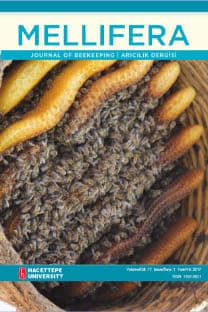Türkiye'nin Ege, Marmara, Akdeniz ve Karadeniz Bölgelerinde toplanmış ballarda polen analizi
Bu çalışmada Türkiye'nin Ege Bölgesi'nden 31, Marmara Bölgesi'nden 17, Akdeniz Bölgesi'nden 24 ve Karadeniz Bölgesi'nden 2 örnek olmak üzere toplam 74 çiçek balında polen analizi yapılmıştır. Polen analizlerinde, 12 unifloral bal ve 62 multifloral bal tespit edilmiştir. Çalışmamızın sonucunda 18'i tür düzeyinde ve 67'si de cins düzeyinde olmak üzere 85 farklı taksona ait polen teşhis edilmiştir. Buna göre Castanea sativa, Centaurea, Eucalyptus camaldulensis, Gossypium, Helianthus annuus, Isatis tinctoria, Lotus corniculatus, Marrubium vulgare, Pimpinella anisum, Salix vulgare, Salvia verticillata, Trifolium ve Vicia cracca dominant polenlere sahip takson, Anthemis, Astragalus, Centaurea, Eryngium campestre, Gossypium, Helianthus annuus, Linaria arvensis, Lotus cornicalatus, Marribium vulgare, Olea, Pimpinella anisum, Solidago, Trifolium, Triticum vulgare, Xanthium ve Vicia cracca sekonder polenlere sahip takson, diğer 64 takson ise minor ve eser polene sahip taksonlar olarak adlandırılmıştır.
Pollen analyses of honeys from Aegean, Marmara Mediterranean and Black Sea Regions in Turkey
This study presents the pollen analyses of 74 floral honeys from the following regions of Turkey. 31 samples from Aegean, 17 samples from Marmara, 24 samples from Mediterranean and 2 samples from Black Sea. The pollen analyses revealed 12 unifloral honeys and 62 multifloral honeys. Pollen have been identified pertaining to 85 taxa, 67 of which were at genus level and 18 were at species level. The dominant group of pollen grains consisted of: Castanea sativa, Centaurea, Eucalyptus camaldulensis, Gossypium, Helianthus annuus, Isatis tinctoria, Lotus corniculatus, Marrubium vulgare, Pimpinella anisum, Salix vulgare, Salvia verticillata, Trifolium and Vicia cracca. The secondary group of pollen grains consisted of:Anthemis, Astragalus, Centaurea, Eryngium campestre, Gossypium, Helianthus annuus, Linaria arvensis, Lotus cornicalatus, Marribium vulgare, Olea, Pimpinella anisum, Solidago, Trifolium, Triticum vulgare, Xanthium and Vicia cracca. The remaining 64 taxa pollen grains were defined as the minor and rare groups.
___
- ISSN: 1302-5821
- Başlangıç: 2001
- Yayıncı: Hacettepe Üniversitesi
Sayıdaki Diğer Makaleler
Nepal'in Chitwan bölgesindeki farklı arı türlerinin ballarındaki polen analizi
Surendra Raj JOSHİ, Hermann PECHHACKER
Türkiye'nin Ege, Marmara, Akdeniz ve Karadeniz Bölgelerinde toplanmış ballarda polen analizi
Ulviye KUMOVA, Turan SAĞLAMTİMUR, Ali KORKMAZ
Türkiye ve Bulgaristan kökenli propolis örneklerinin kimyasal bileşimi ve biyolojik aktiviteleri
Milena VELİKOVA, Vassya BANKOVA, Simeon POPOV, Atanas KUJUMGİEV, Kadriye SORKUN
